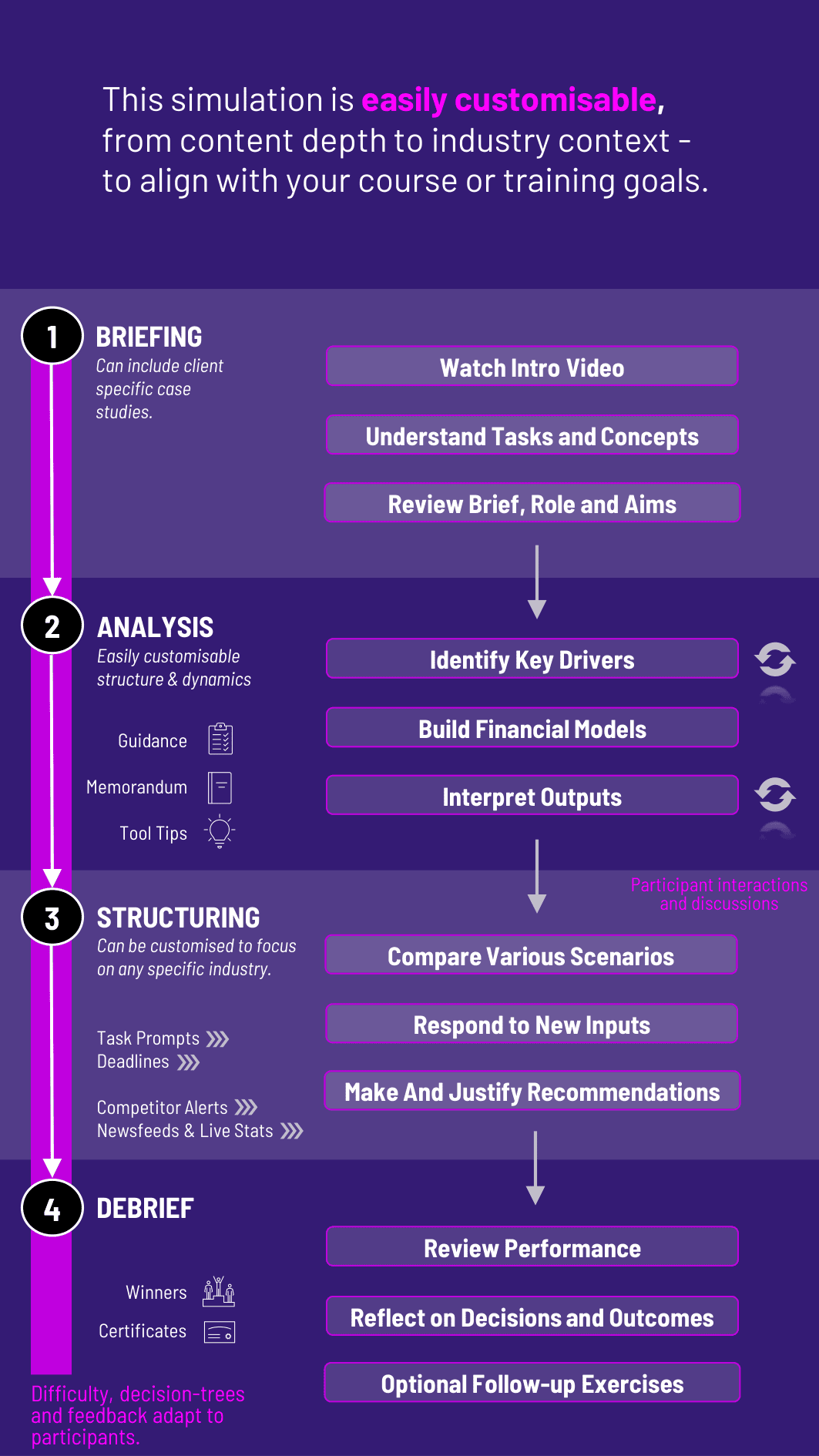
In this analytical Scenario Analysis Simulation, participants test financial and strategic outcomes under different assumptions. They learn how to assess uncertainty, model trade-offs, and guide better decision-making in high-stakes situations.
Scenario Thinking: Building structured what-if cases for complex business choices
Sensitivity vs. Scenario Analysis: Understanding the difference and when to use each
Key Drivers Identification: Selecting the most impactful variables to test
Financial Modeling: Linking assumptions to P&L, cash flow, and valuation
Decision-Making Under Uncertainty: Choosing strategies with the best risk-return balance
Strategic Flexibility: Planning for contingencies and response strategies
Data Communication: Presenting complex results to non-technical stakeholders
Iterative Learning: Adjusting scenarios as new information becomes available


Review a brief for an initiative - such as launching a product, entering a new market, or investing in a new facility
Identify key drivers of uncertainty and define possible scenarios
Build or adjust financial models to capture case-specific outcomes
Compare and interpret outputs under each scenario (base, best, worst)
Make and justify a recommendation to senior leadership or a board
Respond to new inputs or market shifts, refining the analysis dynamically
Collaborate with peers or functionally across teams, depending on the format
By the end of the simulation, participants will be more confident in:
Applying structured thinking to ambiguous business problems
Translating assumptions into financial outcomes
Using scenario and sensitivity analysis effectively
Communicating recommendations grounded in data
Understanding the risks and returns of each strategic path
Making decisions in environments of incomplete information
Balancing optimism and caution in forward-looking planning
Collaborating on decisions that cross finance, operations, and strategy
Adapting decisions in real time as new variables emerge
The simulation’s flexible structure ensures that these objectives can be calibrated to match the depth, duration, and focus areas of each program, whether in higher education or corporate learning.
1. Receive a Business Case or Brief Participants are given a high-stakes business initiative along with initial data and assumptions.
2. Identify Key Drivers and Build Scenarios They define the top variables that affect outcomes and model three or more scenarios - best-case, base-case, and worst-case.
3. Run Financial Models Using the simulation interface and spreadsheets, participants test different combinations of assumptions and explore the results.
4. Make a Recommendation Based on results, participants present a decision or strategy to senior stakeholders - explaining logic, risks, and expected returns.
5. Respond to New Information Additional rounds may introduce new data or surprise developments, requiring scenario revision or re-analysis.
6. Reflect and Debrief Teams or individuals review what drove success or failure, how assumptions changed outcomes, and how better modeling improves strategic thinking.
Is this suitable for students with no modeling experience? Yes. The simulation includes built-in support and can be tailored for beginner to advanced learners.
What tools are used? The simulation uses a built-in platform interface but also integrate Excel models where relevant.
Can it be customised for specific industries? Yes. Scenarios can reflect retail, tech, energy, banking, or any sector.
Does it require math-heavy analysis? Not necessarily. It focuses on logic, assumptions, and strategic decision-making - numbers support the thinking.
Can it be used in executive programs? Yes. It's well-suited for corporate leaders making capital allocation, growth, or restructuring decisions.
Is it individual or team-based? Both are possible. Teams can collaborate to reflect cross-functional dynamics.
Can it include external shocks like regulation or competitor moves? Yes. Additional rounds can introduce new variables that stress-test plans.
How long does it run? Typically 2 - 3 hours for one full cycle, or it can be extended into multi-session workshops.
Is visual presentation part of the task? Yes. Participants must often present scenario outcomes using charts or summaries to stakeholders.
How is performance measured? By clarity of assumptions, logic of recommendations, realism of analysis, and communication effectiveness.
Scenario structuring and assumption clarity
Depth and accuracy of financial impact modeling
Risk-awareness and contingency planning
Strategic quality of decision-making
Quality of presentation and stakeholder alignment
Peer and instructor review in multi-team formats
Adaptability as new inputs emerge during the simulation
You can also include memo writing and debrief presentations as part of the assessment structure. Additionally, you can also add a built-in peer and self-assessment tool to see how participants rate themselves. This flexibility allows the simulation to be easily integrated by professors as graded courses at universities and by HR at assessment centres at companies.
Join this 20-minute webinar, followed by a Q&A session, to immerse yourself in the simulation.
or
Book a 15-minute Zoom demo with one of our experts to explore how the simulation can benefit you.